Common menu bar links
Institutional links
Diseases & Conditions
Health & Safety
Research & Statistics
Agency Information
Search Box
HIV/AIDS - An Attitudinal Survey
Final Report
Previous | Table of Contents | Next
6. Behaviour
6.1 Sexual Behaviour
Just over two-thirds of Canadians (68 per cent) reported that they have been sexually active in the last twelve months. The majority (87 per cent) have had only one sexual partner in that time, while twelve per cent have had two or more sexual partners in the last year. The majority (86 per cent) have been in a regular relationship with this or these sexual partners, while 13 per cent reported a casual partner in the past year. Finally, the vast majority (93 per cent) reported that their sexual relationships in the past year were heterosexual, while seven per cent said that their relationships were homosexual. (Less than one per cent engaged in both homosexual and heterosexual relations.)
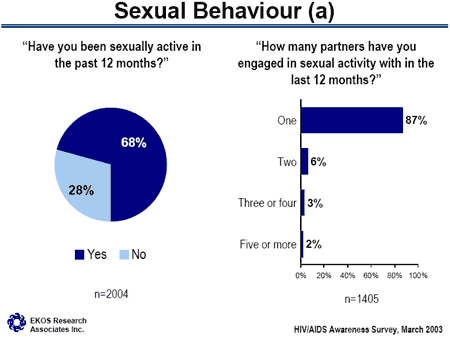
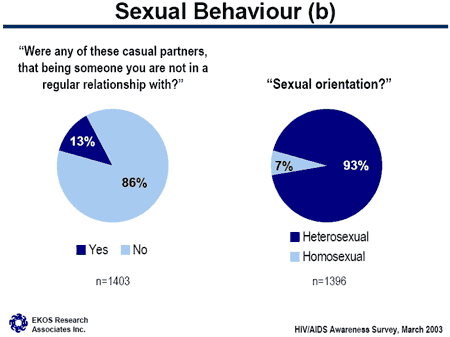
- Men (71 per cent), those aged 25 to 34 (87 per cent) and 35 to 44 (84 per cent) are more likely to indicate that they were sexually active in the past year.
- Canadians with children are more likely to have been sexually active in the last year (89 and 78 per cent respectively), likely driven by age of the respondent.
- Sexually active individuals, men (15 per cent), youth under 25 (34 per cent), and consequently, those with the lowest incomes and no children are all more likely to have had two or more sexual partners in the past year. In fact, 43 per cent of those reporting three or more partners are under the age of 30 (even though only 15 per cent of the overall sample is under 30). Individuals reporting two partners more often report their household composition to be living alone, single parent with a children, single with a roommate(s) or living with their family (i.e., parents). People reporting three partners most often report themselves to be a single person living alone or single living with roommates.
- These same demographic groups are more likely to report casual partners. A total of 17 per cent of men and 18 per cent of Canadians with no children report a casual partner in the previous year. The likelihood of having a casual partner decreases with age (from 31 per cent of those under 25 to two per cent of those 65 and older). The household compositions most often reported for this group are living alone, single parent with children, single with a roommate(s) or living with their family (i.e., parents) (although 27 per cent of individuals who reported casual partners reported themselves to be part of a couple).
- Men and Atlantic Canadians are more likely to indicate that they have had a same sex partner(s) in the past year.
| In summary, sexual activity is linked to gender and age. Men and youth are more likely to be sexually active, more likely to have had several partners, and more likely to report a casual partner. As noted in Chapter Four, individuals reporting casual partners or multiple partners are more likely to perceive themselves to be at moderate or high risk of contracting HIV, compared with other Canadians. |
6.2 Understanding and Practice of Safer Sex
The survey explored both the motivations and behaviour of Canadians with respect to safer sex. After being asked why they believe someone would practice safer sex (findings presented in Chapter Two), respondents were told that safer sex refers to sexual practices that lower the risk of catching or giving a sexually transmitted infection (including HIV/AIDS), which would include the use of a condom or abstinence from sexual intercourse. They were then asked questions about whether and how often they practiced safer sex over the previous year and their motivations for their behaviour.
Based on the above definition, close to half of Canadians (48 per cent) reported that they never engaged in safer sex during the previous twelve months, while just over one-quarter (27 per cent) always did. One in ten practiced safer sex rarely or some of the time over the last year, and a further 10 per cent did most of the time.
The most common method of safer sex used by Canadians over the last year is the condom (used by 72 per cent). Less than one in ten indicated they limited themselves to a single partner (seven per cent), or abstained from sexual intercourse (six per cent). A further eight per cent said that they used the birth control pill, although this contraceptive method does not meet the definition of safer sex provided in the survey.
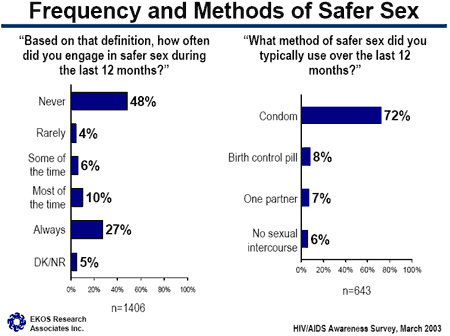
- Of the individuals who reported casual partners, 44 per cent said that they practice safer sex all of the time and 23 per cent practice it most of the time (but 20 per cent of people with casual partners reported that they never practice safer sex). Similarly, 49 per cent of those with two partners practice safer sex all of the time and 44 per cent of those with three partners do the same. Another 22 per cent of people with two partners and 35 per cent of individuals with three partners practice safer sex most of the time.
- The groups that tend to report casual and multiple partners (i.e., youth, men and those with no children) are most likely to practice safe sex all or most of the time.
- The method of safer sex chosen by individuals with casual or multiple partners is almost always the use of a condom (according to 84 to 88 per cent of these segments of society).
- Men are more likely to report the use of a condom (75 per cent did), and women to report the use of the birth control pill (10 per cent). Youth are most likely to report the use of a condom or the birth control pill in the last year (84 and 16 per cent, respectively).
People who engaged in safer sex over the last year were then asked what their primary reason was for doing so, and those who did not were asked the primary reason for deciding not to practice safer sex. Risk of pregnancy was the primary reason for safer sex cited most often (by 35 per cent), followed by the risk of sexually transmitted diseases (27 per cent) or the risk of HIV/AIDS (cited by 10 per cent). A smaller number reported their primary reason for practicing safer sex was simply general responsibility (seven per cent), or due to their partner's request (four per cent).
The vast majority (87 per cent) of those who did not practice safer sex indicate that they did not do so because they have only one sexual partner. A small minority indicated that they are not at risk of STDs (four per cent), that their partner(s) have been recently tested for HIV/AIDS (one per cent), that they assume their partner(s) do not have HIV/AIDS (one per cent), that they were not prepared for safer sex (one per cent), or that they were trying to get pregnant (three per cent).
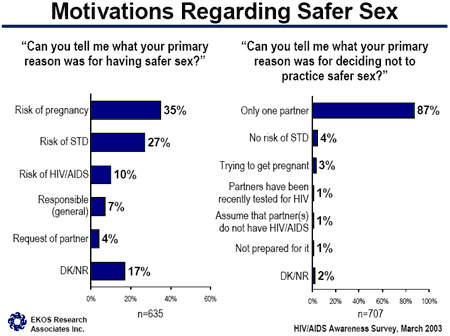
- Individuals with casual partners are more likely to have cited the risk of sexually transmitted diseases (STDs) than other Canadians.
- Those under the age of 25 are more likely to cite risk of STDs as the primary reason for engaging in safer sex (37 per cent do), while those age 25 to 34 and 35 to 44 are more likely to cite risk of pregnancy as the motivating factor (50 and 43 per cent, respectively).

- Those with children who are younger than teens are also more likely to cite risk of pregnancy as the primary reason for safer sex (48 per cent do), while those with no children are more likely to point to risk of STDs as the primary motivator (30 per cent do), a relationship that is likely driven by age of the respondent.
- Quebec residents are more likely to cite risk of HIV/AIDS as the primary reason for engaging in safer sex (16 per cent did).
- In terms of reasons not to practice safer sex, individuals with casual partners were more likely than individuals without casual partners to assume that partners did not have HIV/AIDS (14 per cent) or that they were not prepared for the encounter (11 per cent). Those without casual partners typically offered the explanation of having only one partner as their reason for not practicing safer sex (89 per cent).
- Women are more likely to cite having only one partner as a reason not to practice safer sex (90 per cent do). Those aged 25 to 34 are more likely to indicate trying to get pregnant as the reason not to (nine per cent do), while those aged 35 and over are more likely to indicate that they did not practice safer sex as they had only one partner.
So, individuals with casual or multiple partners, youth, and those with no children are more likely to cite the reduced risk of sexually transmitted diseases as reasons for practicing safer sex. Quebec residents are more likely to cite the reduced risk of HIV/AIDS specifically, while those between the ages of 25 and 44 and parents with children who are not yet in their teens are more likely to cite the reduced risk of pregnancy. In terms of reasons for not practicing safer sex, those with casual partners are more likely to assume their partners did not have the disease or that they were not prepared for the encounter. Women and individuals aged 35 and over are more apt to have had only one partner, while people between 25 to 34 are more likely to be attempting to conceive a child. |
Those who indicated that they have been sexually active in the last year were then asked whether their practice regarding safer sex has changed over the last twelve months, and, if so, why. A minority (seven per cent) have changed their practice regarding safer sex in the past year, while the vast majority (91 per cent) have not.
Those who have changed their practice regarding safer sex cite a variety of reasons as to why. Just over one in four (26 per cent) indicated that they are more concerned now, while a smaller proportion (16 per cent) said that they are less concerned. Others stated that they have changed their practices as they are now better informed (17 per cent), have only one partner (14 per cent), have more partners (five per cent), or are trying to get pregnant (eight per cent).
- The likelihood of having changed practices with respect to safer sex decreases with age, from 18 per cent of those under 25 to zero per cent for senior citizens. It also decreases with income, from 17 per cent of those earning less than $20,000 to two per cent of individuals earning $80,000 or more.
- Individuals reporting casual and multiple partners are also somewhat more likely to report that their practice has recently changed (16 to 18 per cent among those with casual partners and reporting two partners, and 22 per cent among those reporting three partners).
- Those with no children are also more likely to indicate that they have changed their practice regarding safer sex in the past year (nine per cent have), likely driven by age of the respondent.
- Those who believe the risk of HIV/AIDS has increased in the last five years, and who rate their knowledge level as high, are also more likely to have altered their practice in the last year (10 and 11 per cent, respectively).
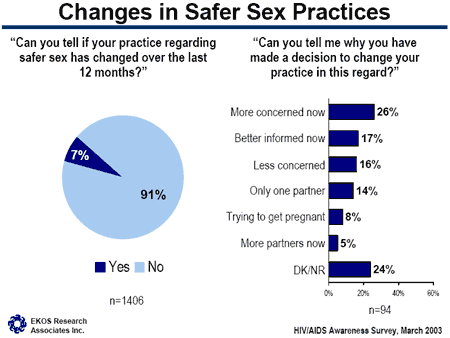
6.3 Testing Behaviour
Just over one-quarter of Canadians (27 per cent) indicate that they have been tested for HIV, excluding testing for insurance, blood donation and participation in research.
Those who have been tested were asked how often they have been tested for HIV/AIDS in the past two years. Four in ten (42 per cent) have not been tested in the past two years, while a similar number (38 per cent) have been tested once in the past two years, and 18 per cent have been tested two times or more.
Individuals who have been tested for HIV were also asked where they had their most recent test conducted. Most have had their most recent test conducted in a doctor's office (63 per cent have). One in ten (10 per cent) have had their most recent test at a sexual health clinic, and seven per cent at an anonymous clinic. Close to two in ten (19 per cent) had their most recent test performed somewhere other than these locations.

- A higher proportion of those who are currently sexually active reported being tested for HIV (32 per cent versus 14 per cent among the non-sexually active). Also, percentage of Canadians being tested is higher among individuals reporting casual partners (45 per cent). This percentage increases with the number of partners as well, with 30 per cent of individuals with one partner saying that they were tested, rising to 41 per cent among those with two partners and 51 per cent among those with three partners.
- Women are somewhat more likely than men to have been tested at some point (29 per cent versus 24 per cent). Canadians aged 25 to 34 and 35 to 44 are also more likely to have been tested (46 per cent and 35 per cent respectively), as are those with younger children (45 per cent) and those who know someone with HIV/AIDS (35 per cent).
- Those with high perceived or actual knowledge (30 per cent), a high level of comfort with people with HIV/AIDS (34 per cent) and who are less likely to distance themselves from HIV/AIDS (33 per cent) are also more likely to indicate that they have been tested for HIV/AIDS.
- Those with high school education or less are less likely to have ever been tested (23 per cent have).
- Of those who have been tested, however, it is youth who are most likely to have been tested once or more in the past two years (91 per cent have), which fits with the profile of youth as having multiple and casual partners more often.
- The number of tests reported by individuals with casual partners and those with two and three partners is also higher than reported for their counterparts. For example, 1.51 tests were reported for those with casual partners, compared with .86 tests reported for those without casual partners.
- Residents from Quebec, men, those with no children, and individuals born outside Canada are more likely to have had their most recent test performed at a sexual health clinic.
| In summary, testing for HIV is more common among those who are currently sexually active and who report casual and multiple partners. This also holds true for women, those aged 25 to 44, parents with younger children and individuals who know someone with the disease. In addition, people with high (perceived or actual) knowledge, those with high comfort levels around people with HIV/AIDS and people who are less apt to distance themselves from the issue are more apt to have been tested for HIV/AIDS in the past two years. A higher frequency of testing is reported among youth and those with casual or multiple partners. |
